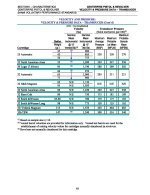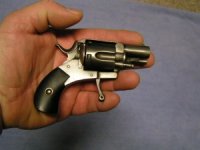FoundFather
New member
Say what? Crazy, right? Chamber pressure is too high, it's going to blow up in your hand! But let's have a closer look.
The standard advice, of course, is that you can shoot the older, shorter cartridges in revolvers chambered for longer, magnum, rounds, but not vice versa. Think 38 Special in a 357 Mag, but not the other way round. Fine.
BUt .32 S&W, commonly called .32 S&W Short, is actually rated by SAAMI for higher pressures than .32 S&W Long, 17,000 PSA for the Short and 15,000 PSI for the Longs using transducer method:
 Link: https://saami.org/wp-content/upload...FP-and-R-Approved-2015-12-14-Posting-Copy.pdf
Link: https://saami.org/wp-content/upload...FP-and-R-Approved-2015-12-14-Posting-Copy.pdf
Using crusher method, they are both rated at 12,000 PSI.
So the Long is not necessarily a +P when loaded in the Short.
Next objection is that the longs are, well, loooong, and they just won't fit in the chamber of Shrot revolver. That's where the wadcutters come in. .32 S&W Long wadcutters are loaded flush with the case mouth of of a .32 S&W Long case, which happens to be 0.92 inches long. And what is the cartidge OAL of a .32 S&W Short? You guessed it! 0.92 inches. So the "Long" wadcutters will fit.
Why would anyone do this, you might ask? I have scoured the interwebs and can't find .32 S&W Shorts anywhere. .32 S&W Long wadcutters are readily available. The cheapest at the momoent are these from Magtech: http://magtechammunition.com/products/ammunition/32-sw-long-98gr-lwc/
That cartridge uses a 98 grain bullet and pushes it at 682 fps for a muzzle energy of 102 ft lbs. Wikipedia cites "Cartridges of the World" for 98 grain bullet going 705 fps for a muzzle energy of 115 ft lbs (not clear to me what barrel lengths were used so might not be perfect apples-to-apples comparison). The Magtechs seem to be in spec for the .32 S&W Short.
I know lots of .32S&W Short revolvers were designed for black powder, use a top latch mechanism, were cheaply built when new and usually not maintained, so they may not be safe with any cartridge. Assume we are talking about a solid frame, 20th ceturry .32 S&W Short revolver designed for smokeless powder in good mechanical condition.
Is this crazy? If so, why?
The standard advice, of course, is that you can shoot the older, shorter cartridges in revolvers chambered for longer, magnum, rounds, but not vice versa. Think 38 Special in a 357 Mag, but not the other way round. Fine.
BUt .32 S&W, commonly called .32 S&W Short, is actually rated by SAAMI for higher pressures than .32 S&W Long, 17,000 PSA for the Short and 15,000 PSI for the Longs using transducer method:
 Link: https://saami.org/wp-content/upload...FP-and-R-Approved-2015-12-14-Posting-Copy.pdf
Link: https://saami.org/wp-content/upload...FP-and-R-Approved-2015-12-14-Posting-Copy.pdfUsing crusher method, they are both rated at 12,000 PSI.
So the Long is not necessarily a +P when loaded in the Short.
Next objection is that the longs are, well, loooong, and they just won't fit in the chamber of Shrot revolver. That's where the wadcutters come in. .32 S&W Long wadcutters are loaded flush with the case mouth of of a .32 S&W Long case, which happens to be 0.92 inches long. And what is the cartidge OAL of a .32 S&W Short? You guessed it! 0.92 inches. So the "Long" wadcutters will fit.
Why would anyone do this, you might ask? I have scoured the interwebs and can't find .32 S&W Shorts anywhere. .32 S&W Long wadcutters are readily available. The cheapest at the momoent are these from Magtech: http://magtechammunition.com/products/ammunition/32-sw-long-98gr-lwc/
That cartridge uses a 98 grain bullet and pushes it at 682 fps for a muzzle energy of 102 ft lbs. Wikipedia cites "Cartridges of the World" for 98 grain bullet going 705 fps for a muzzle energy of 115 ft lbs (not clear to me what barrel lengths were used so might not be perfect apples-to-apples comparison). The Magtechs seem to be in spec for the .32 S&W Short.
I know lots of .32S&W Short revolvers were designed for black powder, use a top latch mechanism, were cheaply built when new and usually not maintained, so they may not be safe with any cartridge. Assume we are talking about a solid frame, 20th ceturry .32 S&W Short revolver designed for smokeless powder in good mechanical condition.
Is this crazy? If so, why?


